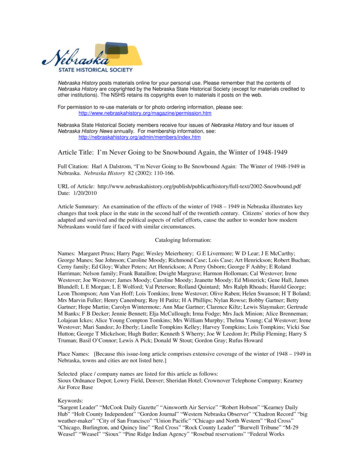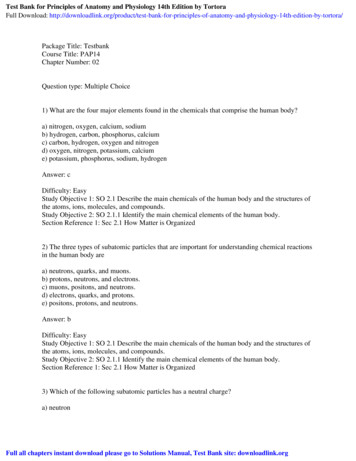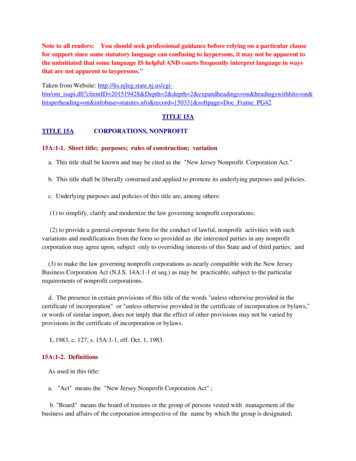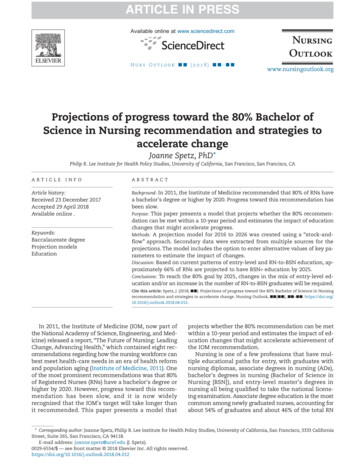
Transcription
Nebraska History posts materials online for your personal use. Please remember that the contents ofNebraska History are copyrighted by the Nebraska State Historical Society (except for materials credited toother institutions). The NSHS retains its copyrights even to materials it posts on the web.For permission to re-use materials or for photo ordering information, please sion.htmNebraska State Historical Society members receive four issues of Nebraska History and four issues ofNebraska History News annually. For membership information, .htmArticle Title: I’m Never Going to be Snowbound Again, the Winter of 1948-1949Full Citation: Harl A Dalstrom, “I’m Never Going to Be Snowbound Again: The Winter of 1948-1949 inNebraska. Nebraska History 82 (2002): 110-166.URL of Article: story/full-text/2002-Snowbound.pdfDate: 1/20/2010Article Summary: An examination of the effects of the winter of 1948 – 1949 in Nebraska illustrates keychanges that took place in the state in the second half of the twentieth century. Citizens’ stories of how theyadapted and survived and the political aspects of relief efforts, cause the author to wonder how modernNebraskans would fare if faced with similar circumstances.Cataloging Information:Names: Margaret Pruss; Harry Page; Wesley Meierhenry; G E Livermore; W D Lear; J E McCarthy;George Manes; Sue Johnson; Caroline Moody; Richmond Case; Lois Case; Art Henrickson; Robert Buchan;Cerny family; Ed Gloy; Walter Peters; Art Henrickson; A Perry Osborn; George F Ashby; E RolandHarriman; Nelson family; Frank Bataillon; Dwight Margrave; Harmon Holloman; Cal Westover; IreneWestover; Joe Westover; James Moody; Caroline Moody; Jeanette Moody; Ed Misterick; Gene Hall, JamesBlundell; L E Morgan; L E Wolford; Val Peterson; Rolland Quintard; Mrs Ralph Rhoads; Harold George;Leon Thompson; Ann Van Hoff; Lois Tomkins; Irene Westover; Olive Raben; Helen Swanson; H T Boland;Mrs Marvin Fuller; Henry Canenburg; Roy H Patitz; H A Phillips; Nylan Rowse; Bobby Gartner; BettyGartner; Hope Martin; Carolyn Wintermote; Ann Mae Gartner; Clarence Kiltz; Lewis Slaymaker; GertrudeM Banks; F B Decker; Jennie Bennett; Elja McCullough; Irma Fodge; Mrs Jack Minion; Alice Brenneman;Lolajean Ickes; Alice Young Compton Tomkins; Mrs William Murphy; Thelma Young; Cal Westover; IreneWestover; Mari Sandoz; Jo Eberly; Linelle Tompkins Kelley; Harvey Tompkins; Lois Tompkins; Vicki SueHutton; George T Mickelson; Hugh Butler; Kenneth S Wherry; Joe W Leedom Jr; Philip Fleming; Harry STruman; Basil O’Connor; Lewis A Pick; Donald W Stout; Gordon Gray; Rufus HowardPlace Names: [Because this issue-long article comprises extensive coverage of the winter of 1948 – 1949 inNebraska, towns and cities are not listed here.]Selected place / company names are listed for this article as follows:Sioux Ordnance Depot; Lowry Field, Denver; Sheridan Hotel; Crownover Telephone Company; KearneyAir Force BaseKeywords:“Sargent Leader” “McCook Daily Gazette” “Ainsworth Air Service” “Robert Hobson” “Kearney DailyHub” “Holt County Independent” “Gordon Journal” “Western Nebraska Observer” “Chadron Record” “bigweather-maker” “City of San Francisco” “Union Pacific” “Chicago and North Western” “Red Cross”“Chicago, Burlington, and Quincy line” “Red Cross” “Rock County Leader” “Burwell Tribune” “M-29Weasel” “Weasel” “Sioux” “Pine Ridge Indian Agency” “Rosebud reservations” “Federal Works
Warm au&weather mingledwith days heralding winter markNovember in Nebraska. The first twoweeks of November 1948 were typicalas temperatures occasionally climbedinto the 60s and 70s Fahrenheit, punctuated by cold spells and scattered snow.Harrison, in the northwestern comer of thestate, had some twelve inches of snow ina fourday period, but this hint of winterwas very local. Nature was bountiful aswell as benign, and Nebraskans couldtake comfort in a U.S. Department ofAgriculture estimate that the 1948 corncrop would be outstanding. Little didthey realize that they were on the brinkof one of the worst winters in the state'shistory.'Harl Dalstrom is Professoro f Histoiy at theUniversityo fNebraska at Omaha. Among hishis previous publications are biographies o fEugene Eppley and A. V. Sorensen. He iscurrently working with two other scholars ona history o f metropolitan Omaha.Blizzards are not rare in the GreatPlains, but a relatively sparse populationand great distances make the regionespecially vulnerable to the combinedonslaught of snow and wind. The winterof 194849 was particularly memorablebecause a series of storms betweenNovember and February paralyzed alarge area of the northern Plains, including the northern third of Nebraska.Between storms the persistent threat ofhigh winds drifting newly opened roadsshut again was as great a worry as prospect of more snow.Following the normal pattern, local,county, and state authorities handledroad clearing early in the winter, but in thewake of a massive blizzard on January2-5, it became evident that Nebraska andother states would need large-scale federalassistance. Timely, well-coordinatedaid, coordinated by the Fifth Army andthe Army Corps of Engineers, wouldprove essential in averting disaster.The winter of 1948-49, illustratingas it does the climatic extremes of theGreat Plains, is an important episodein the region's history. Great weatherevents, especially those covering extensive areas, become landmarks in apeople's perception of their past. "TheWinter of the Deep Snow" of 1830-31was such an event for early settlers inparts of Indiana and Illinois. LauraIngalls Wilder's The Long Winter and theclimax of 0. E. Rolvaag's Giants in theEarth commemorate the winter of 188081 on the northern Plains. The blizzardof January 1888 has endured in the loreof the Great Plains, and the blizzard ofMarch 1888 left a similar impression onthe northeastern United States.'A massive snowdrift, higher than thefarmhouse eves and 150 feet long, almostobscures the Ernest Kiel home nearLewellen, Garden County, January 5, 1949.NSHS-RG3139-50
Winter of 1948-49 in NebraskaAlthough images of nature's rigorsare basic to how Nebraskans understand the pioneer experience, the lore ofclimatic excesses, unlike other pioneericons, continues to accumulate. Personsborn in this region in the 1930sundoubtedly heard family stories ofblowing dust, the bitter cold winter, andblazing hot summer of 1936 long beforethey read about the Dust Bowl. Morerecently, Omaha residents whosememories go back to 1975 will alwaysassociate that year with the great January blizzard and the devastating Maytornado. For Nebraskans and others whoendured the winter storms in 1948-49,the experience stands out boldly.Beyond the twenty- and thirty-footsnowdrifts, stalled trains, and dramaticdetails of the relief activity, however,is another story that is, perhaps, moreimportant. Because repeated storms inthis long winter severely disrupted normalpatterns of life over much of Nebraskaand neighboring states, the disruptionsbecome a path to understanding someaspects of routine life in the mid-twentiethcentury. The winter's brunt fell upon anarea with no large cities and few largetowns; hence, the insights gained fromthis wide-area diiruption relate primarilyto rural life. From the vantage point ofsome fifty years later, an examinationof the effects of the winter of 1948-49permits us to draw some conclusionsabout key changes in Nebraska in thesecond half of the twentieth century.As the third week of November1948 began, Nebraska continuedto have pleasant weather with hightemperatures ranging from the 50s tothe 70s. Tuesday, November 16, was abit cooler, but the next morning anOmaha World-Heraldheadline asserted,"Weather to Stay Fair, Warmer," and thestory observed, "Nebraskans will havedifficulty reconciling the weather withthe calendar." Yet on Wednesday afternoon, Sidney in the southern Panhandlehad thunder, lightning, rain, and sleet,soon followed by snow. Strong windscaused considerable drifting throughthe night. By the next morning, U.S.Highway 30, then Nebraska's principaleast-west road, was closed east ofSidney. Even so, the state forecast onThursday morning read: "Cloudy, fewshowers south- east, snow flurries innortheast, then clearing; colder; highsnear 40." Perhaps more germane wasthe U.S. Weather Bureau's map whichshowed a low-pressure system overColorado. The Panhandle proved to beon the edge of a storm that would haveafternoon, Harry Page and two othermen came to the school and arrangedto lead youngsters and Margaret Prussto the Page home, some one-half mileto the east. Before setting out, Pagestressed the importance of stayingtogether:So we got in line-Mr. Page, thethree children, myself, [and] theother two men. Mr. Page hadbrought a rope with him; he hadOn November 18-1 9 the first storm of the 1948-49 winter almost buried the H. R.Holcomb home near Chambers, Holt County. Enlarged by subsequent storms, thedrifts persisted through April 1949. NSHS-RG3139-72its greatest impact in an area from southwestern to northeastern Nebraska onThursday and Friday, November 18-19.At O'Neill, young Margaret Pruss,teacher at the Bredehoeft School somefour miles from town, arose on Thursday morning to what she rememberedas a "very damp and cloudyn day.As she left home, she yielded to hermother's insistence that she take herboots. By 8:00 A.M. it was snowing at herschool and only three children werepresent. "By 9:00, the snow was soheavy it was impossible to see out thewindows." At noon she advised theyoungsters to save some of their lunchesfor later and she brought extra coalfrom the school basement to feed thestove through the night. However, thateach take hold of the rope so wecould stay together. Mr. Page got usto his house safely. The storm wasso fierce; we could barely see theperson in front.Not until the evening of Monday,November 22, would Margaret Prussmake it home. In the meantime, in anera when not all rural residents had telephones, her mother could only discover"that I might be at the Page home."3On Thursday morning, Dr. Wesley C.Meierhenry of the Teachers College,University of Nebraska, set out fromLincoln for Newman Grove, where hewould teach an extension class.Lincoln's weather was so mild that hedid not wear an overcoat or take any
Nebraska History - Fall/Winter 2002other winter clothing. At Humphrey, heencountered the storm front, but he gotto Newman Grove and proceeded withhis class. However, after 7:30 that evening,the electricity went off, and contrary tothe advice of local people, Meierhenryset out for Lincoln. Driving a shortdistance south was no problem, butwhen he turned east, the absence ofvisibility forced him to open his windowto watch the road. Making it to Lindsay,he made the mistake of pressing onthrough the rolling country towardHumphrey, but atop one hill, amid snowand winds exceeding seventy-five milesper hour, his car went off the road andbogged down in mud. Meierhenry madetwo treks from his car in search of aidbefore he saw that he would have tospend the night in his vehicle. Hisresources for warmth included mimeographed class materials that he used tocreate a barrier between his body andhis wet clothing, and his auto's gasolinesupply, which lasted until around10:OO A.M. Friday. The storm still raging,he used some of his audiovisual instructional equipment to make a head coverthat would prevent his eyes from icingshut as he walked in search of shelter.He followed fenceposts until he saw abranch power line that led him to afarm home and safety."At Burwell, the storm intensifiedon Thursday and reached its peak onFriday. Snowdrifts of six to eight feetand higher paralyzed the town, whichwould be without mail or bus serviceuntil the following Monday. One personon a nearby farm estimated the wind atfifty to seventy miles per hour and said:You couldn't see 50 feet-it wasjust blank white. The snow stuck toall sides of the buildings 3 and 4inches thick, and over the windowsand into woven wire fences, whichmade them look like stone walls.Burwell had its own electric plantand had few power outages, but Albion,sixty-five miles east, would be withoutelectricity for some fifty-five hours afterutility poles east of town were toppledfollowing an apparent lightning strike onThursday evening. Many Albion residentswhose furnaces were electricallygoverned took refuge with neighborswhose home heating did not rely uponpower service. Other Nebraska communities experienced power failuresbecause of the ice, wind, and heavy,wet snow.When the storm abated at Spaldingon Friday afternoon, it left drifts of up totwelve feet. Because of blocked roads,milk sales on Saturday were restrictedto people with infants. To the west, atSargent, the editor of the Sargent Leader,G. E. Livermore, who had been aresident of the area since 1883, wrote,"This storm was one of the worst thewriter has ever seen here."Opening roads drifted shut in the November storm, like this one near the H. R. Holcomb farm,was a huge task, but only the beginning of a long winter's work. NSHS-RG3139-71
Winter of 194849 in NebraskaMcCook, the principal town in southwestern Nebraska and a division pointon the Chicago, Burlington and QuincyRailroad, saw train service come to ahalt. The storm was particularly hardon the railroad's centralized trafficcontrol system. McCook was withoutlong distance telephone service as weresome one hundred other Nebraskatowns, and the storm disrupted WesternUnion telegraph service. For two daysthe McCook Daily Gazette was withoutits wire service and had to rely on newscasts from radio stations around theregion for some material. Greeley, acounty seat in central Nebraska, wasphysically cut off from the outside whena large cut through which the rail lineand highway entered the town from theeast was filled with snow.In the storm-stricken areas of Nebraska,hotels were filled with motorists; otherpeople on the road were fortunate toreach farmhouses or other shelter. AtLexington, which was without electricityfor over thirty hours and had no waterservice during part of this time, some onehundred travelers found shelter in ahotel built for sixty persons. However,the situation was worse in westernKansas, where sriowdrifts strandedhundreds of highway travelers andpassenger trains on three lines.Six Nebraskans died as a result ofwhat some elderly residents comparedto the famed blizzard of January 12,1888.Others, perhaps more accurately, concluded that it was the worst Novemberstorm in the state's history. The WeatherBureau described the storm a s "one ofthe most severe blizzards of record overmuch of the central and northeasternportions of the State." Between Thursday,November 18, and Saturday, November20, McCook received eleven and threeinches of snow, and snowfallelsewhere in southcentral and southwestern Nebraska ranged from six tonine inches.Albion received twenty inches, butthe most snow came in the BloomfieldHartington area in the northeast, wheretwenty to twenty-four inches fell. TotalsAlthough outside the main path of the storm, high winds left the Louis Vap farm, nearGlenville, Clay County, locked in a frozen sea of drifts. NSHS-RG3139-57fell off rapidly beyond the main path ofthe storm; for example, on November 19Atkinson, in north-central Nebraska, hadsixteen inches of snow, but thirty-onemiles west, Bassett received some fourinches. Ainsworth, seventeen miles westof Bassett, had only a trace of snow forthe entire month. The storm brought aten-inch snowfall to Fremont, butOmaha, thirtysix miles to the southeast,had heavy rain followed by sleet andtwo inches of snow. Lincoln had threeinches of snow, while most of the precipitation in far southeastern Nebraskawas rain.5In the next few months, the use ofaircraft for emergency services to snowblocked farms and ranches becamean absolute necessity. On Saturday,November 20, Dr. W. D. Lear ofAinsworth, just beyond the storm area,was called to attend Mrs. J. E. McCarthywho had been in labor for at least thirtyhours. Although drifts blocked roads tothe McCarthy home northwest of Burwell,Lear learned that a nearby pasture wasclear enough for a plane to land. GeorgeManes of the Ainsworth Air Serviceflew Lear and Sue Johnson, a nurse, theseventy-five miles to the makeshift landing strip. Walking from the plane to thehouse meant getting around drifts ashigh as ten feet, but the mission endedsuccessfully. For Manes, this would bethe start of a long winter's work.In the wake of the November storm,Northwestern Bell Telephone Companyhad 1,750 felled poles and 5,000 wirebreaks to cope with in Nebraska. McCookPublic Power District linemen workedfrom the afternoon of November 18 untilthe evening of November 20 makingrepairs, and the district had to secureadditional help from a rural electrificationconstruction crew. In northcentralNebraska, opening roads was a majortask, and some areas went without mailfor many days.As the storm continued its diagonalpath, it struck a heavy blow at southeast-
Nebraska History - Fall/Winter 2002the deepest snow in the northern thirde m South Dakota, northwestern Iowa,and southwestern Minnesota. When itof the state. Although Bassett receivedmoved over the Lake Superior region,twelve inches, southern portions ofwinds at Duluth broke the steel mooring Rock County had upwards of two feet.8cables securing the excursion ship S.S.O'Neill was covered with eighteenWayne and drove the vessel into a coalinches, and the Holt County Independentdock a half-mile away. The Robertdeclared:Hobson, an 11,900-tonore camer, wasIt will be some time before roadsrun aground at the Wisconsin entranceare open again here, and some hadinto the port of Duluth-Superior.just been opened after the Nov. 18thRelatively mild temperatures duringstorm. Mail camers will be unableand after the storm abated the humanto make their routes for sometimesuffering and kept livestock losses low.[sic] until the roads can be opened.Although there were some significantturkey losses, the snow probably helpedwinter wheat crops, particularly insouthwestern Nebraska, which hadexperienced a dry a t u m n . Although the first few days ofDecember were very mild, moreseasonal conditions returned on thefifth and sixth. The cold winds. whichsnapped this warm spell, brought"blinding dustn to the High Plainsaround Sidney. Winds bringing a coldwave on December 19 and 20 causedmore blowing soil and damage to thewheat crop in the Panhandle and southwestern part of.the state. Residents ofSidney, buffeted by sixty-mile-per-hourwinds, called it the worst dust stormsince the famed Dust Bowl days of 1934.7As Christmas approached, the forecast called for snow, and on December23 and 24, three to sixteen inches fellacross the state. In general the windswere not strong, and the precipitationcaused few problems, though travel wasrestricted in some areas of the Panhandle.There, the snow was a blessing for thedry land and wind-ravaged wheat.Two bulldozers from Council Bluffs, Iowa,On December 28 freezing drizzleclear roads near Mclean in Pierce County.followed by "moderate to heavy snow,"Northeastern Nebraska bore the brunt ofand winds of forty to fifty miles per hour the November storm. Courtesy NeilBecker, Omahamoved across Nebraska, again fromsouthwest to northeast. This storm wasIn northeastern Nebraska, driftingfar less damaging than that of Novemproved to be almost as troublesome asber 18 and 19, but drifts clogged roadsand many telephone and telegraph lines in November. By contrast, at Chadronwent out of operation. There were some in northwestern Nebraska, the editor ofthe Chadron Record exclaimed, "Goodelectrical service outages, and theKearney Daily Hub could not go to press. old Chadron! We've again missed thesecond big blizzard in the state."The two late December storms left0n Saturday, New Year's Day,1949, the forecast called for lightsnow starting in
parts of Indiana and Illinois. Laura Ingalls Wilder's The Long Winter and the climax of 0.E. Rolvaag's Giants in the Earth commemorate the winter of 1880- 81 on the northern Plains. The blizzard of January 1888 has endured in the lore of the Great Plains, and the











